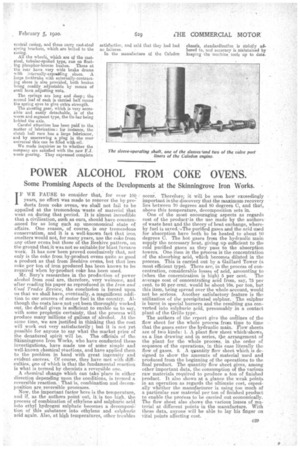POWER ALCOHOL FROM COKE OVENS.
Page 19

If you've noticed an error in this article please click here to report it so we can fix it.
Some Promising Aspects of the Developments at the Skinningrove Iron Works.
IF WE PAUSE to consider that, for over 100 years, no effort was made to recover the by-products from coke ovens, we shall not fail to be appalled at the tremendous -waste of material that went on during that period. It is almost incredible that a civilization, such as ours, should have countenanced for so long such ai uneconomical state of affairs. One reason, of course, is our tremendous conservatism, and it is a well-known fact that iron smelters would not, for many years, use the coke from any other ovens but those of the Beehive pattern, on the ground that it was not so suitable for blast furnace work. It has now been proved conclusively that, not only is the coke from by-product ovens quite as good a product as that from Beehive ovens, but that less coke per ton of iron produced has been known to be required when by-product coke has been used.
Mr. Bury's researches in the production of power alcohol from coal are, therefore, very welcome, and triter reading his paper as reproduced in the Iron and Coal Trades Review, the conclusion is forced upon ' us that we shall have,• eventually, a magnificent addition to our sources of motor fuel in the country. Although the costs have not yet been thoroughly worked out, the detail given is sufficient to enable us to say, with some prophetic certainty, that the process will produce many millions of gallons of alcohol. At the same time, we are justified in thinking that the cost will work out very satisfactorily ; but it is not yet possible for anyone to say what the market price of the denatured spirit will be. The officials of the Skinningrove Iron Works, who have conducted these investigations, have made use of some simple and well-known chemical reactions, and have applied thern to the problem in hand with great ingenuity and evident success. Of course, they have met with difficulties, iine of which is that the fundamental reaction is what is termed by chemists a reversible one.
A chemical change which can take place in either direction depending upon the conditions, is termed a reversible reaction. Thafis, combination and decomposition are reversible processes.
Now, the important factor here is the temperature, and if, as the authors point out, it is too high, the process of combination of ethylene and sulphuric acid into ethyl hydrogen sulphate becomes a decomposi: tion of this substance into ethylene and sulphuric acrid again, Also, at high temperatures, other troubles occur. Therefore; it will be seen how 'exceedingly important is the discovery that the maximum-recovery lies between 70 degrees and 80 degrees C, and that, above this temperature, decomposition sets in.
One of the most encouraging aspects as regards cost of the products is the use made by the authors of waste heat and the theory of heat exchange, whereby fuel is saved.The purified gases and the acid used for absorption have both to be heated to about SO degrees Cl. The hot gases from the hydraulic main supply the necessary heat, giving up sufficient to the cold purified gases as they pass to the absorption towers. One item in the process is the concentration of the absorbing acid, which becomes diluted in the process. This is carried out by a Gaillard Tower (a most efficient type). There are, in the process of concentration, considerable losses of acid, amounting to (when the concentration is high) 5 per cent. The average cost of concentrating acid from, say, 75 per cent. to 95 per cent. would be about Hs. per ton, butthis item, being spread over the whole account, would not be serious. Another satisfactory feature is the utilization of the precipitated sulphur. The sulphur is burnt in special burners and-the resulting gas converted into sulphuric acid, presumably in a contact plant of the Grillo type.,
The authors of the report give the outlines of the flow sheet for the whole process from time to time that the gases enter the hydraulic main. Flow sheets are of two kinds: 1. A plant flow sheet which‘shows, as a line drawing and in series, the arrangement of the plant for the whole process, in the order of sequence of the operations, in this case literally the flow of gases. 2. A quantity flow sheet which is designed to show the amounts of material used and produced from the beginning of the operations to the final product. The quantity flow sheet gives, among other important data, the consumption of the various raw materials required to produce a ton of finished Product. It also shows at a glance the weak points in an oueration as regards the ultimate cost, especially whether the manufacturer is using too much of a particular raw material per ton of finished product to enable the proCess to be carried out economically. The flow sheet also shows the various losses of material at different points in the manufacture. With these data, anyone will be able to lay his finger on vital points affecting cost.






























